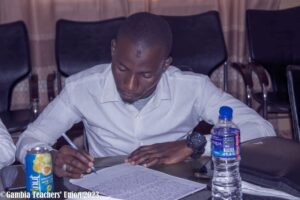SENEGAMBIA: A VICTIM OF GEOPOLITICAL DISMEMBERMENT
Date published: 6th August, 2024
Publisher: IPRO-MINISTRY, EDUSA
By: Berray Sowe [Fourth year, Final Semester History Major- University of The Gambia and Current Secretary General of the 14th Executive Council of EDUSA]
August, 2024

At the instance of historical fairness, a visitor from the sky to the earth will be perplexed to understand that the Greater Senegambia Region- which was a vast unique supernatural framework that encapsulated various peoples with their politico-economic and socio-cultural homogeneities and lived together for hundreds of years before the commencement of an astronomical geopolitical disintegration from the Fifteenth century to the Twentieth century as a result of European infiltration, leading to the creation of artificial and absurd boundaries- is today a fragmentation of six nation-states of people who adopt different alien linguistic, socio-cultural, and politico- economic lifestyles, with compartmentalised peoples- of the same ancestry- that are submerged into foreign educational, judicial, and economic systems.
These present nation-states, according to Professor Boucarr Barry, are The Gambia, Senegal, Guinea Bissau, Mauritania, Mali and Guinea Conakry; while three of them: The Gambia, Senegal, and Guinea Bissau were wholly part of the Senegambia framework, the other three: Mauritania, Mali, and Guinea Conakry were partially in the framework.
Geographically divided into two- Northern and Southern Senegambia- by the River Gambia and covered both River Senegal and River Gambia, the Senegambia Region was a home of diverse ethnolinguistics such as the Wolof, Fula, Mandinka, Jola, Sereres, Majagko, Susu, Bainuk, Nalu, Befada, Papel, and Basari, etc.
Fertilely, the Senegambia Region was also a sanctuary for migratory individuals searching for productive land, political stability, and economic decorum; this led to the exodus of thousands of migrants into the region, at a very early time. These peoples established polities, Kingdoms, and empires such as Tekrur, Jollof, Kaabu, Cayor, Sin, Saloum, etc.
In congruity to the historicism enshrouding the geopolitical dismemberment, this article is a roundup that interrogates the interconnectedness and nexus between the geopolitical apportion of the Greater Senegambia Region, its subsequent impacts, and the prospective fate of its present people and states.
Historically, the dismemberment or disintegration of the Greater Senegambia Region started from the Fifteen Century, as the influence of Western presence had altered its politico-economic and socio-cultural status-quo.
Completely, in the Second-half of the Nineteenth Century [1850-1900], the entire Greater Senegambia was shared among the European powers of Britain, France, and Portugal. The Anglo-French Convention of 1889 gave the British full responsibility of governing the Gambia and the French of governing Senegal, sundering people of the same progenitors who had lived together for centuries. It was not up until the 1960s that political independence was attained.
In consequence of the geopolitical decomposition, the Senegambia region has a history of being divided by colonial powers, which has had lasting effects on the region’s political, economic and social dynamics.
Foremost, the division of the region has led to a fragmentation of ethnic groups and cultures, creating tensions and conflict between neighbouring countries. The principle of ‘’Divide and Rule’’, which was the mantra of the rapacious and prejudiced European colonialists was an advertent and well calculated strategy employed to culturally and politically delinked people of the same origin and keep them subservient to Western domination. Its effects were devastating and despicable; it brought enmity and mistrust among the same but colonially divided people.
Going further, the dismemberment of the Senegambia region has also resulted in challenges for the current nation states in the region. The borders drawn by colonial powers were arbitrary and did not take into account the ethnic and cultural realities of the region. This has led to issues of identity and belonging, as well as competition over resources and power. Each state is egoistic, looking only at its individual interest in lieu of the entire progression of the region.
Finally and cogently, the apportion of the Senegambia Region actuated colonial rule. The elimination of the Senegambian traditional rulers such Lat Jor Diop, Albury Njie, Foday Kombo Sillah, Foday Kaba Dumbuya, Momodou Lamin Drammeh, Musa Molloh, etc. and the creation of the modern nation-states led to the institutionalisation of Western-oriented educational, political, judicial, agricultural, and economic systems: an arrangement meant to immortally kowtow the people and their resources to Western influence.
To cap it all, the so-called concept of Anglo-phone, Franco-phone, and Luso-phone has left the Senegambian peoples in the divisive hands of linguistic domination and chain, keeping them linguistically asunder.
Apropos of the catastrophic impacts of the geopolitical dismemberment on the states and peoples of the Senegambia Region, the prospective fate of its present states and peoples can be made improved by the below-expounded literally point men.
To move forward, the present nation states in the Senegambia Region must work towards building strong relationships and partnerships with each other. By recognising and respecting the cultural diversity of the region, and promoting dialogue and cooperation, these nations can overcome the legacy of colonialism and work towards a more peaceful and prosperous future.
Handsomely, it is also important for these nation states to address the underlying causes of conflict and tension in the region, such as economic inequality, political instability, and social injustices. By addressing these issues and working towards inclusive development and governance, the Senegambia region can build a more sustainable and peaceful future for its people.
Conclusive, the modern nation states in the Senegambia Region need a central source for the solutions to their common and shared problems. As posited by Dr Kwame Nkrumah, ‘’The existence of common problems calls for common solution, and common solution calls for common institutions guided from a central source.’’ Thus, the modern nation states in the Senegambia Region need to harmonise and syncronise their institutions, policies, and programmes under one larger regional canopy that is capable of addressing its overall needs.
Article By: Berray Sowe
